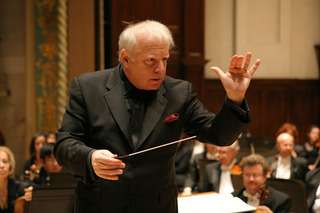|
Back
Ecstasy, Cacaphony and One Coitus Interruptus New York
Isaac Stern Auditorium, Carnegie Hall
05/10/2013 -
“Spring For Music”: “Ives Immersion”
Charles Ives: Symphonies No. 1 in D Minor, No. 2, No. 3, "The Camp Meeting" & No. 4
Vivian Perlis (Commentator)
UMS Choral Union Chamber Singers, Jerry Blackstone (Music Director), Detroit Symphony Orchestra, Teddy Abrams (Assistant Conductor), Leonard Slatkin (Music Director/Conductor)

C. Ives (© Wikipedia Commons)
Leonard Slatkin’s ground-breaking, and frankly breathtaking concert of all four Ives symphonies last night was like following the career of Pablo Picasso. Like Picasso’s early realistic pictures, Ives’s First Symphony was a beautifully assembled late 19th Century derivative piece, albeit with some quirky modulations. His Second Symphony could have been Cubist Picasso. We recognized the themes, the melodies were not off-putting. But if the artists didn’t actually pulverize their subjects, they did disassemble them giving us new looks (and sometimes explosive moments).
The third Ives was a throwback to another time, a pleasant reminiscence of an earlier age. But like Picasso’s surrealistic, violent last time, beginning with Guernica, Charles Ives let all the stops loose in his final symphony–written just three years after Stravinsky’s Sacre, but not performed until have a century later.
Conductor Slatkin was at that concert, and he confessedly “hated it.” But Leonard Slatkin, ever the artist, in an incredibly informative illustrated lecture before the piece, also confessed that he had to see why it disturbed him. And he also dissected some of the more blaring passages, giving reasons for a second conductor. And while I’ve heard this piece hundreds of times, I never realized that while the drums, brass and winds were playing their own music, the strings were playing Turkey in the Straw.
This was a truly astonishing concert. For the mass of Detroiters and Michiganians in the audience, Mr. Slatkin may have done the impossible in his missionary work. They may never have heard (or in some cases, heard of) Charles Ives. But after last night, they are all bound to be Ives fanatics.
For those us of familiar with Ives, not only did Slatkin give us some dynamic performances with the Detroit Symphony, but the evolution of the composer, the dissection and assemblage of the music was also a revelation.

L. Slatkin (© Detroit Symphony Orchestra)
Much of the revelation was that Ives in his symphonies was not that great a revolutionary. His songs and string quartet and Concord Sonata were the Ives of massive sounds and gigantic aural visions. The symphonies, save for the explosions of the Fourth and the last chords of the Second, are rather conservative.
Where other composers used European forms (canons, fugues etc), Charles Ives was perhaps the greatest quodlibet composer who ever lived. Yes, Mozart and Bach could balance out five themes at once, but Ives took five popular American tunes and made them oppose each other. In fact, more than ever one can see the Ives influence on his student Elliott Carter, who, more often than not, gave each instrument its own character, and let the devil take the hindmost.
As we see genius in the earliest Picasso, the First Symphony was both craftsmanlike and–in those strange modulations of the simplest themes–Ives’ introduction to uprooting his orchestra. In the Second, Mr. Slatkin treated the last movement the way Mahler treated his Fifth finale. Giving hints, nuances suspicions of the final movement, but then letting it play with full flare at the end.
The difference was that Mahler made the grand finale sound like the trumpets of heaven. Ives, in the grandest movement, gave his orchestra a coitus interruptus, with the cornet tootling out the wakeup Reveille.
Slatkin played the Third with all due reverence, and the final offstage ring of the bell was the single touch of an angel. Of course the Fourth, where Mr. Slatkin gave his short delightful lecture, Ives, a one-time organist, literally let out all the stops. A quarter-tone piano, massive percussion, a men’s chorus in the outlying movements...
Still, one of my favorite moments was at the very end of the third movement academic fugue for strings and trombone on one hymn. Instead of letting it go at that, Charles Ives segued oh so gently into lines from Joy to the World.
We all know the last words for the first verse, “Let heaven and nature sing.” And Charles Ives obviously knew the second verse as well, a paean to the Transcendentalists he admired so well:
“Let men their songs employ;/While fields and floods,/Rocks, hills, and plains/Repeat the sounding joy.”
This was an homage which Ives sounded his entire life. Mr. Slatkin brought it to radiant light last night.
Harry Rolnick
|